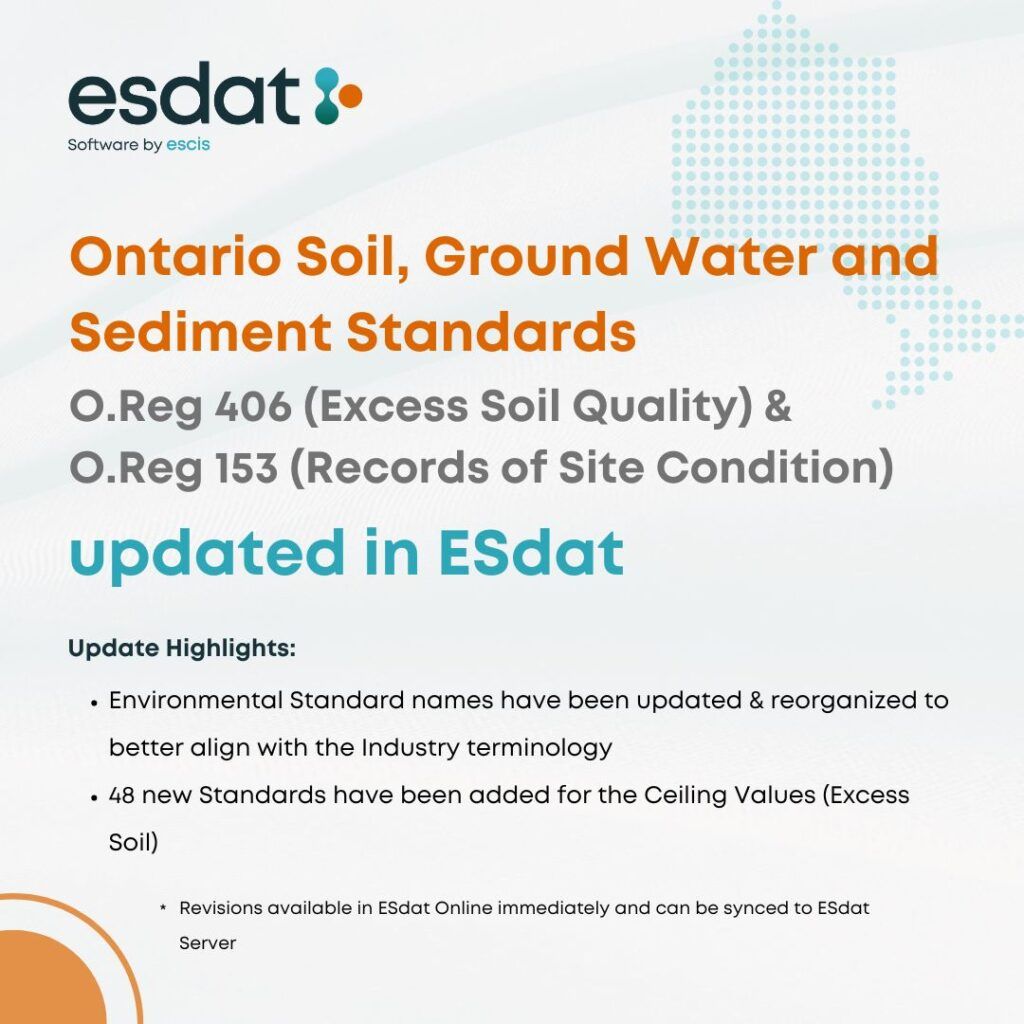The Government of Ontario’s Soil, Groundwater, and Sediment Standards—O.Reg 406 (Excess Soil Quality) and O.Reg 153 (Records of Site Condition)—have been updated in ESdat to better reflect industry terminology.
The naming & organization of these standards should now be more intuitive for users, and the addition of 48 new standards for the Ceiling Value criteria in O.Reg 406 (Excess Soil) should further support our Ontario users as they maximize their reporting efficiency through comparison against our published standards. https://esdat.net/environmental-standards/

Ontario’s Soil, Groundwater, and Sediment Standards protect human health and the environment by limiting soil, groundwater, and sediment contaminants. These standards are crucial for evaluating site conditions, managing contaminated lands, and ensuring the safe development or reuse of properties.
Key Functions of the Standards:
1. Environmental Protection: The standards limit the concentration of harmful contaminants in soil, groundwater, and sediment to prevent adverse effects on ecosystems, water quality, and public health.
2. Risk Management for Site Remediation: The standards are used for environmental assessments and remediation work. They help determine whether a site is contaminated and guide the cleanup process to meet safe levels for future use.
3. Record of Site Condition (RSC): Property owners must meet these standards to file an RSC when redeveloping contaminated land (brownfield sites). The standards ensure that sites are safe for their intended future use (residential, commercial, industrial, etc.).
4. Guidance for Soil Reuse and Disposal: The standards clarify whether excess soil from construction or excavation can be reused on other sites or must be treated as waste, influencing its disposal or repurposing.
5. Site-Specific Risk Assessments: In some cases, site-specific standards may be developed using these general standards as a base, ensuring tailored protection for more complex or unique environmental conditions.
Contaminants Covered:
The standards cover various potential contaminants, including metals, petroleum hydrocarbons, volatile organic compounds (VOCs), and other hazardous chemicals.
Ontario’s soil, groundwater, and sediment standards serve as a regulatory benchmark to ensure contaminated sites are properly managed, human health risks are minimized, and environmental integrity is maintained during site redevelopment or reuse projects.
Summary of Excess Soil Regulations
https://www.ontario.ca/laws/regulation/190406
Ontario has introduced new rules for reuse, on-site processing, and disposal of excess soil. Here are the key points to quickly understand the changes:
• 2021: Rules for reusing and processing excess soil came into effect.
• 2022: New requirements began for testing, tracking, and filing notices related to excess soil.
• 2025: Restrictions will start for depositing excess soil at landfill sites, but certain exceptions apply (e.g., for landfill cover or construction).
Key Regulations to Note:
1. Amendments have been made to key regulations, including Ontario’s Records of Site Condition and Waste Management rules.
2. Definition of Projects: Projects under this regulation include all development or site alterations.
3. Exemptions: Certain excavations are exempt from the regulation.
4. Beneficial Purpose: Excess soil must serve a useful purpose, such as backfill for excavation or grading for development projects.
5. Site-Specific Instruments: If a site has specific instruments, excess soil must comply with quality and quantity standards mentioned in those instruments.
6. Reuse Site Conditions: Conditions include a beneficial purpose, adherence to quality standards, and final placement of soil within two years of deposit.
7. Quality Standards: Excess soil must meet generic or site-specific standards.
Key Changes to Ontario Regulation 406/19 (On-Site and Excess Soil Management)
O.Reg 406/19, which governs excess soil management in Ontario, has seen several changes since its introduction. Here are the significant updates and amendments:
1. 2021: Initial Rollout of Rules
• Reuse and On-Site Processing: Regulations came into effect requiring proper reuse and management of excess soil on-site or at reuse sites.
• Designation as Waste: Excess soil may be classified as waste if not reused or managed correctly.
2. 2022: New Requirements Introduced
• Testing and Tracking: All excess soil must now undergo testing to ensure it meets quality standards for reuse. Tracking the movement of excess soil is mandatory.
• Filing Notices: Project leaders must file notices about the generation and movement of excess soil to a centralized registry.
3. 2025: Future Restriction on Landfilling
• Ban on Excess Soil at Landfills: Beginning in 2025, excess soil that meets specific quality standards will not be deposited in landfill sites, except in special cases (e.g., using excess soil for daily cover or infrastructure at landfill sites).
4. Amendments (2020 Update)
• Project Area Definition: A ‘project area’ now includes a single property or adjoining properties where the project is being carried out.
• Beneficial Use Clarification: The term ‘beneficial purpose’ remains undefined, but examples provided include backfill, grading, and other development-related uses.
• Site-Specific Instruments: Regulations now allow for site-specific instruments (permits or approvals) that define the quality and quantity of excess soil permitted for use at a reuse site.
• Quality Standards: The regulations provide more straightforward guidance on excess soil quality standards, including generic standards for different reuse scenarios.
Notable Exemptions and Conditions to O.Reg 406:
• Some excavations are exempt from O.Reg 406/19.
• Excess soil must be used for a beneficial purpose at reuse sites, and the soil’s quality must meet provincial or site-specific standards.
• The soil must be placed within two years after its deposit at the reuse site, and the site cannot be used primarily for depositing excess soil.
Generic Excess Soil Quality Standards
• Part II of the regulation outlines quality standards for excess soil not subject to site-specific instruments, ensuring safe reuse in various development scenarios.
ESdat is intuitive and user-friendly software that helps scientists and engineers manage environmental and earth-science data from laboratories, field programs, data loggers, sensors, historical sources, and regulatory standards. All in one place.
Related articles
What are Canada’s environmental guidelines and policies?
The Efficiency Equation: Assessing Your Data Governance for Improved Workflow Performance.
Canadian Soil Quality Guidelines for PAHs: Protecting Environmental and Human Health






